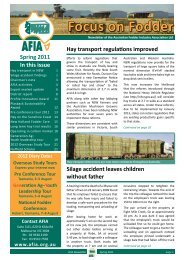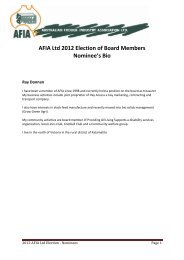AFIA - Laboratory Methods Manual - Australian Fodder Industry ...
AFIA - Laboratory Methods Manual - Australian Fodder Industry ...
AFIA - Laboratory Methods Manual - Australian Fodder Industry ...
You also want an ePaper? Increase the reach of your titles
YUMPU automatically turns print PDFs into web optimized ePapers that Google loves.
Method – 1.1R: How to Take <strong>Fodder</strong> Samples for Analysis<br />
Version 2<br />
Date 31/08/05<br />
Scope: This procedure is used to obtain fodder samples for analysis; separate methods are used<br />
for hay and silage.<br />
Principle: The accuracy of fodder analysis depends on the sample sent to the laboratory. It is<br />
critical that the sample represents the average composition of the "lot" of fodder sampled; otherwise<br />
the laboratory tests will not be useful.<br />
A "lot" is defined as hay or silage taken from:<br />
- the same species (pure or mixed) and variety;<br />
- the same paddock or pit/bunker; and<br />
- harvested within 48 hours.<br />
Other factors influencing the definition of a "lot" include:<br />
- rain damage;<br />
- weed content;<br />
- soil type;<br />
- treatment after cutting; and<br />
- storage effects.<br />
A "lot" of baled hay or cubes should not exceed 200 tonnes.<br />
Sampling Equipment: Representative hay samples can only be obtained with a probe or core<br />
sampling device. Do not rely on a couple of handfuls or a "flake" from one bale.<br />
• <strong>Australian</strong> made corers are available from:<br />
KELSPEC SERVICES, PO Box 31, Dunkeld, Victoria 3294 (phone 03 5577 2624);<br />
• Several types are also marketed in the USA.<br />
• A home-made corer can be made from 32mm steel tubing. It should be at least 450mm long<br />
with a slightly scalloped and sharp cutting edge.<br />
• Corers are driven using either a hand brace or by a continuously variable speed, electric drill<br />
(preferred option where practicable). A portable generator is useful and can be justified if<br />
many samples are to be taken. Cordless drills can be used if they meet power (torque)<br />
requirements.<br />
Sample Size Reduction:<br />
The original sample will normally require reducing in size prior to further processing. There are two<br />
ways this can be achieved: By use of a riffle box or by sample coning and quartering. The riffle box<br />
is preferred for certain sample types (e.g. fine chopped maize forage) in that it is faster and yields a<br />
marginally better sub-sample. However, it requires specialist equipment, and for some sample<br />
types, it can be prone to blocking.<br />
Riffle Box: These devices are also known as sample splitters and are available commercially.<br />
The sample is split into two equivalent portions via a series of gates. One half is usually discarded,<br />
and the other retained for analysis, or for further sample reduction<br />
<strong>AFIA</strong> <strong>Laboratory</strong> <strong>Methods</strong> <strong>Manual</strong> – v7 September 2011 Page 8 of 103







